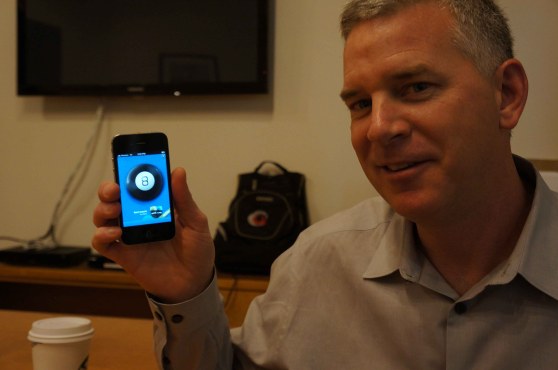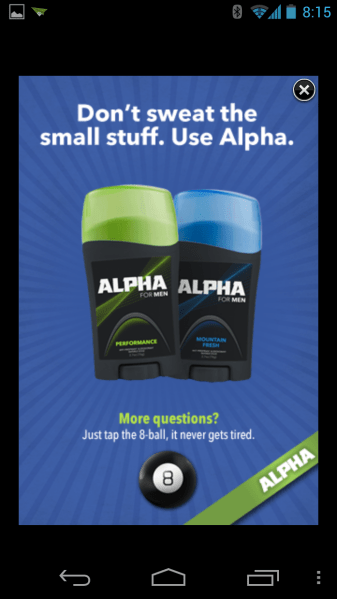Let’s be frank: Mobile ads suck. Not only are they dull and not making anyone as much money as they should, but people aren’t even clicking them intentionally. In fact, almost forty percent of mobile clicks are made by accident, according to a recent report from eMarketer.
While lots of companies are throwing lots of money at the problem, voice software maker Nuance is looking at it from another, more interesting angle: Instead of focusing on clicks as the success metric for mobile ads, Nuance wants to use voice recognition to engage people in a way that banner ads never could.
“We’re taking the voice assistant tech out of apps and putting it in ads,” Nuance advertisement vice president Mike McSherry said of Voice Ads, Nuance’s new voice-enabled ad platform.
While Nuance’s voice tech is already used in cars, businesses, and hospitals, McSherry says that Voice Ads owes a lot to Siri, Apple’s own voice assistant software. “Siri created an industry. People play with it. It’s witty. Why not give these same sorts of tools to ad agencies?” McSherry said.
Can mobile ads be…entertaining?
At the core of Voice Ads is measurable engagement, which is something that’s been pretty rare for advertising. Think about it this way: For most of its history, advertising has been a one-way street. You watch television and advertisers talk to you via commercials; you read VentureBeat and advertisers serve you banner ads (which can be relevant to you but often aren’t). Absent in both those things, of course, is actual engagement: Advertisers are saying quite a lot to you, but you’re not saying much back in return.
That idea is turned on its head with Voice Ads, which gives advertisers a tool to interact consumers in a way that’s both direct and, well, entertaining.
To illustrate this somewhat crazy idea, McSherry opened up an interactive magic eight-ball ad for Alpha, a fictional deodorant brand. “Should I buy that ring?” he asks the ad, which, after responding affirmatively advises McSherry to “use Alpha”, which “smells like money in the bank.” (He did this multiple times, with multiple questions, all of which returned unique responses. Nuance’s tech is definitely robust.)
The conversation was largely silly, but it was still enjoyable to watch — and that’s exactly the point. McSherry wasn’t just watching an advertisement — he was interacting with it.
While Alpha is a hypothetical brand, the sort of engagement that example demonstrates would be ideal for real companies like Geico, which has already built its brand presence around the voice of its gecko mascot. Just imagine an advertisement that allows the Geico gecko to give you personal insurance advice based on your vocal input. (If Geico’s ad guys aren’t already brainstorming something like this, I’d advise them to get to it.)
More engagement, more data
Aside from engagement, Voice Ads also means data. With the platform’s underlying tech, advertisers have a much better idea of which people are actively — and not accidentally — interacting with their ad campaigns. “We can measure how much people are actually using this stuff. There are no more accidents,” Nuance marketing chief Peter Mahoney pointed out.
All of these factors combine to support one key takeaway: In Nuance’s ideal world, voice ads will do to advertisements what touch screens have done to computing: If your ads don’t have a voice component, lots of people are going to think there’s something wrong with them — just like people now expect all devices to have touch screens.

Above: Coming to a mobile voice ad near you?
That idea, however, is more of a fantasy right now than reality. Before Nuance answers the expectation question, it first has to answer the adoption one: How many brands and ad agencies will actually end up using Voice Ads?
New technology always takes time to percolate, but McSherry seems confident that once advertisers and brands see what can be done with Voice Ads, it’s going to be tough for them justify avoiding it. “Everyone’s trying to create deeper brand experiences on mobile devices. Voice Ads does that,” McSherry said.
So far things are looking good. Not only has Nuance already inked deals with ad firms Digitas, OMD, and Leo Burnett, but it also has digital advertising companies Millenial, JumpTap and Ad Marvel on board as well. That’s a pretty significant vote of confidence for an experiment that’s just starting out. (McSherry will be providing the first wider public demonstration of the technology at the Mobile Summit today in Sausalito, where VentureBeat has invited 180 leading mobile executives to debate ways to push forward the mobile economy).
The other concern is more relevant to the average smartphone user: How much more annoying will voice-enabled ads be than existing ones? As we’ve seen from banner ads, pop-ups, and behavioral tracking, what’s good for advertisers is often not terribly great for users. While McSherry didn’t have a clear answer for how well the average person is going to respond to Voice Ads, Nuance obviously hopes mobile users respond well.
My view? Anything that can help companies make money on mobile is ultimately a good thing. Let’s just not make it too annoying — okay, guys?
Photo: Ricardo Bilton/VentureBeat
VentureBeat's mission is to be a digital town square for technical decision-makers to gain knowledge about transformative enterprise technology and transact. Learn More


